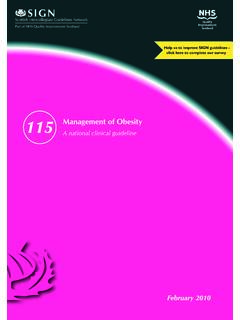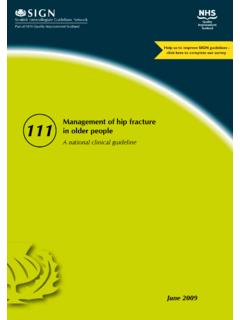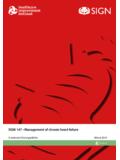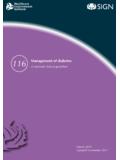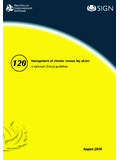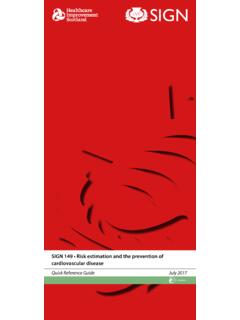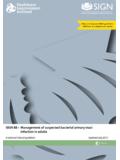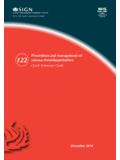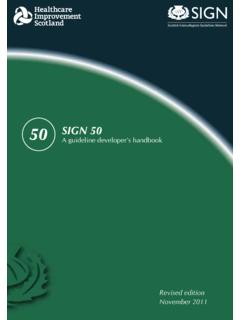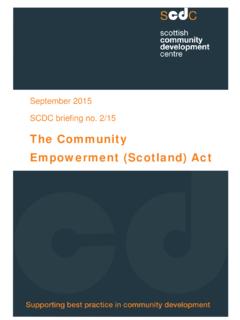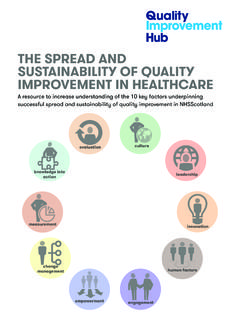Transcription of Part of NHS Quality Improvement Scotland - sign.ac.uk
1 Scottish Intercollegiate Guidelines NetworkPart of NHS Quality Improvement ScotlandSIGNM anagement of sore throat and indications for tonsillectomy A national clinical guidelineApril 2010117 Help us to improve SIGN guidelines -click here to complete our survey KEY TO EVIDENCE STATEMENTS AND GRADES OF RECOMMENDATIONSLEVELS OF EVIDENCE1++High Quality meta-analyses, systematic reviews of RCTs, or RCTs with a very low risk of bias1+Well conducted meta-analyses, systematic reviews, or RCTs with a low risk of bias1 -Meta-analyses, systematic reviews, or RCTs with a high risk of bias2++ High Quality systematic reviews of case control or cohort studies High Quality case control or cohort studies with a very low risk of confounding or bias and a high probability that the relationship is causal2+Well conducted case control or cohort studies with a low risk of confounding or bias and a moderate probability that the relationship is causal2 - Case control or cohort studies with a high risk of confounding or bias and a significant risk that the relationship is not causal3 Non-analytic studies, eg case reports, case series4 Expert opinionGRADES OF RECOMMENDATIONNote: The grade of recommendation relates to the strength of the evidence on which the recommendation is based.
2 It does not reflect the clinical importance of the At least one meta-analysis, systematic review, or RCT rated as 1++, and directly applicable to the target population; or A body of evidence consisting principally of studies rated as 1+, directly applicable to the target population, and demonstrating overall consistency of resultsBA body of evidence including studies rated as 2++, directly applicable to the target population, and demonstrating overall consistency of results; orExtrapolated evidence from studies rated as 1++ or 1+CA body of evidence including studies rated as 2+, directly applicable to the target population and demonstrating overall consistency of results; orExtrapolated evidence from studies rated as 2++DEvidence level 3 or 4; orExtrapolated evidence from studies rated as 2+GOOD PRACTICE POINTS Recommended best practice based on the clinical experience of the guideline development groupNHS Quality Improvement Scotland (NHS QIS) is committed to equality and diversity and assesses all its publications for likely impact on the six equality groups defined by age, disability, gender, race, religion/belief and sexual guidelines are produced using a standard methodology that has been equality impact assessed to ensure that these equality aims are addressed in every guideline.
3 This methodology is set out in the current version of SIGN 50, our guideline manual, which can be found at The EQIA assessment of the manual can be seen at The full report in paper form and/or alternative format is available on request from the NHS QIS Equality and Diversity care is taken to ensure that this publication is correct in every detail at the time of publication. However, in the event of errors or omissions corrections will be published in the web version of this document, which is the definitive version at all times. This version can be found on our web site This document is produced from elemental chlorine-free material and is sourced from sustainable Intercollegiate Guidelines NetworkManagement of sore throat and indications for tonsillectomyA national clinical guidelineApril 2010 ManageMent of sore throat and indications for tonsillectoMyisBn 978 1 905813 62 9 Published april 2010 SIGN consents to the photocopying of this guideline for the purpose of implementation in NHSS cotlandscottish intercollegiate guidelines network elliott house, 8 -10 hillside crescent edinburgh eh7 5ea introduction.
4 The need for a guideline .. Remit of the guideline .. Definitions .. Statement of intent ..22 Key recommendations .. Diagnosis and presentation .. General management .. Surgical management .. Postoperative care ..33 Presentation .. Incidence of sore throat in general practice .. Reasons for presentation in general practice .. Emergency hospital diagnosis of sore Clinical diagnosis .. Throat culture .. Rapid antigen testing ..75 general management of sore throat .. Pain relief in adults .. Pain relief in children .. Adjunctive therapy ..96 antibiotics .. Antibiotics in acute sore throat .. Antibiotics in recurrent sore throat .. Use of antibiotics to prevent rheumatic fever and glomerulonephritis .. Use of antibiotics to prevent suppurative complications.
5 Use of antibiotics to prevent cross infection in sore throat ..127 surgery in recurrent sore throat .. Tonsillectomy rates for all surgical indications .. Evidence for surgery in recurrent tonsillitis .. Referral criteria for tonsillectomy for the treatment of recurrent tonsillitis .. Otolaryngological assessment .. Postoperative care ..16contentscontrol of Pain in adults with cancer8 Provision of information .. Sources of further information .. Checklist for provision of information ..209 implementing the guideline .. Auditing current practice ..2110 the evidence base .. Systematic literature review .. Recommendations for research .. Review and updating ..2211 development of the guideline .. Introduction .. The guideline development group .. Acknowledgements.
6 Consultation and peer review ..24abbreviations ..27annexes ..28references ..35 ManageMent of sore throat and indications for tonsillectoMy11 introduction1 introduction the need for a guideline The management of sore throat is a significant burden on health service resources. Most patients who seek advice see their general practitioner (GP) and in most cases the condition is relatively minor and self limiting. However, a significant number of patients experience unacceptable morbidity, inconvenience, and loss of education or earnings due to recurrent sore throat. The use of antibiotics in patients with recurrent sore throat has been controversial. The indications for tonsillectomy have long been a matter of debate. Tonsillectomy has a small but significant complication rate and an outcome that is not clearly guideline SIGN 34, Management of sore throat and indications for tonsillectomy, was published in 1999.
7 Awareness of the guideline among physicians has led to more efficient and effective use of healthcare In 2005 a consultation document identified the need for an update. This guideline updates SIGN 34 to reflect the most recent evidence. reMit of the guideline OvERAll ObjECTIvES This guideline covers diagnosis, pain management, antibiotic use, indications for surgical management and postoperative care for acute and recurrent sore throat in children and adults. It does not address tonsillectomy for suspected malignancy nor as a treatment for sleep apnoea or peritonsillar abscess. Specific surgical techniques, anaesthetic techniques and organisation of care, eg day case surgery, are not covered. The aim of this guideline is to suggest a rational approach to the management of acute sore throat in general practice and to provide criteria for referral for tonsillectomy in recurrent tonsillitis.
8 The guideline also provides examples of patient information leaflets which may assist in management and facilitate decision making about the need for surgery (see Annexes 2 and 3) and suggests areas for further research (see section ). TARGET USERS Of THE GUIDElINE This guideline will be of particular interest to general practitioners, nurses, paediatricians, pharmacists, otolaryngologists, anaesthetists, public health specialists, patients with recurrent sore throat and their carers. definitions Acute pharyngitis, tonsillitis, or acute exudative tonsillitis may all cause sore throat. for the purpose of non-surgical management, these are considered together under the term sore throat .No accepted definition of childhood exists in Scots law or NHSS cotland.
9 Upper cut-off ages used in studies of children included in this guideline vary from 12 to 16. for the purposes of this guideline, recommendations concerning tonsillectomy in childhood apply to ages 4-16. for prescribing in children, advice in the bNf for Children should be 2 ManageMent of sore throat and indications for stateMent of intent This guideline is not intended to be construed or to serve as a standard of care. Standards of care are determined on the basis of all clinical data available for an individual case and are subject to change as scientific knowledge and technology advance and patterns of care evolve. Adherence to guideline recommendations will not ensure a successful outcome in every case, nor should they be construed as including all proper methods of care or excluding other acceptable methods of care aimed at the same results.
10 The ultimate judgement must be made by the appropriate healthcare professional(s) responsible for clinical decisions regarding a particular clinical procedure or treatment plan. This judgement should only be arrived at following discussion of the options with the patient, covering the diagnostic and treatment choices available. It is advised, however, that significant departures from the national guideline or any local guidelines derived from it should be fully documented in the patient s case notes at the time the relevant decision is taken. PRESCRIbING Of MEDICINES OUTwITH THEIR MARkETING AUTHORISATION Recommendations within this guideline are based on the best clinical evidence. Some recommendations may be for medicines prescribed outwith the marketing authorisation (product licence).
